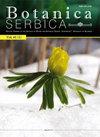毛羽翼头蕨花粉形态的分类意义
IF 1.1
4区 生物学
Q4 PLANT SCIENCES
引用次数: 2
摘要
龙舌兰科孢粉学比较研究。其代表植物的花粉粒形态表现出相当大的多样性。本研究的目的是为以三孔花粉粒为特征的分类群(Pterocephalus plumosus、sucisa pratensis和sucisella inflexa)提供更详细的花粉形态数据。利用光镜和扫描电镜研究了羽石杨的花粉形态。花粉粒为三柱形,近卵圆形至长形;尺寸大。他们的轮廓在极视图(羔羊)是近圆形,很少三叶状。短茎有明显的茎尖和尖端。外壁雕刻为针状-微针状-纳米针状。本研究首次对雨松、草松和冬松花粉粒的外壁结构(小柱)进行了分析。毛羽石竹的花粉粒以中果皮的小柱长而密为特征,外果皮的小柱较长。我们新的形态学数据通过花粉外壁存在较短的稀疏小柱来支持pratensis和S. inflexa之间的密切关系。UPGMA树状图显示了羽茅花粉粒的独特形态特征,因此将其作为一个单独的分支。本文章由计算机程序翻译,如有差异,请以英文原文为准。
Taxonomic significance of pollen morphology of Pterocephalus plumosus (Caprifoliaceae)
Comparative palynological studies of Dipsacaceae s.str. show considerable diversity in the pollen grain morphology of its representatives. The aim of this research was to provide more detailed palynomorphological data on selected taxa whose pollen grains are characterised by tricolpate apertures (Pterocephalus plumosus, Succisa pratensis and Succisella inflexa). The pollen morphology of P. plumosus was studied using both light microscopy and scanning electron microscopy. The pollen grains are tricolpate, suboblate to prolate; large in size. Their outline in polar view (amb) is subcircular, rarely trilobate. The brevicolpi have a distinct margo and acute ends. The exine sculpture is echinate-microechinate-nanoechinate. The exine structure (columellae) of the pollen grains of P. plumosus, S. pratensis and S. inflexa was analysed for the first time in the current study. Pollen grains in P. plumosus are distinguished by long and dense columellae in the mesocolpia, and longer in the apocolpia. Our new ?alynomorphological data support a close relationship between S. pratensis and S. inflexa by the presence of shorter sparse columellae throughout the pollen exine. The UPGMA dendrogram shows the distinctive morphometric characters of P. plumosus pollen grains, which is thus included as a separate branch.
求助全文
通过发布文献求助,成功后即可免费获取论文全文。
去求助
来源期刊

Botanica Serbica
Agricultural and Biological Sciences-Plant Science
CiteScore
1.40
自引率
12.50%
发文量
17
审稿时长
34 weeks
期刊介绍:
Botanica Serbica publishes original research papers on all aspects of plant, fungal and microbial biology research including the disciplines of microbiology, mycology, lichenology, bryology, flora, vegetation, biogeography, systematics, taxonomy, plant biotechnology, plant cell biology, plant ecology, environmental plant biology, forestry, genomics, horticulture, limnology, metabolomics, molecular biology, proteomics, virology, plant conservation and protection, and wildlife and ecosystem management.
 求助内容:
求助内容: 应助结果提醒方式:
应助结果提醒方式:


